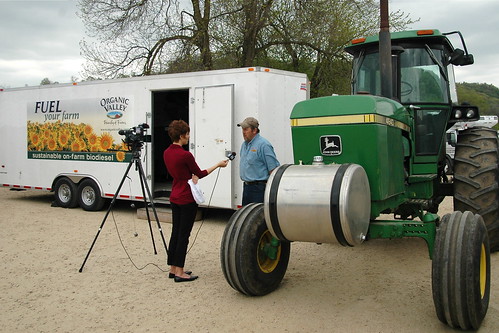a local television station recently came to organic valley/cropp cooperative to get a closer looks at our on-farm sustainability initiative that is testing the use of sunflowers as a source of on-farm fuel. the occasion for the visit was a week long elsbett conversion workshop where three organic valley fleet trucks and three farm tractors were modified to be capable of running both biodiesel and vegetable oil ( see “Vegetable oil for fuel” for the online text version of the story ) .
it was neat to see the interview taking place in front of the “mobile press” featuring one of the sunflower shots i’ve taken over the years ( “the sunnier side of biodiesel” is one of the most popular public sunflower photos but not the one on the side of the press. ). the press can process seeds harvested on the farm and convert them into either straight vegetable oil or biodiesel ( the elsbett conversion is needed to run the straight vegetable oil ).
biodiesel can be a controversial subject because not all of the feedstocks are created equal for a lot of complicated reasons not least of which being competition for acreage for crops destined for food and fuel. more acreage for fuel could theoretically mean less acreage for food or feed – an important concern particularly when you consider the limited amount of acreage that is certified organic. there are a variety of strategies for planting sunflowers to ensure that they don’t compete with food or fuel crops that i won’t go into here.
while i doubt sunflower oil will become a signficant source of fuel for general consumers, it could be an important part of reducing on-farm dependence on fossil fuels for organic valley/cropp cooperative producers.
perhaps rudolf diesel was on to something when he introduced the engine that bears his name:
“The fact that fat oils from vegetable sources can be used may seem insignificant today, but such oils may perhaps become in course of time of the same importance as some natural mineral oils and the tar products are now.”

One thought on “fuel your farm with sunflowers.”